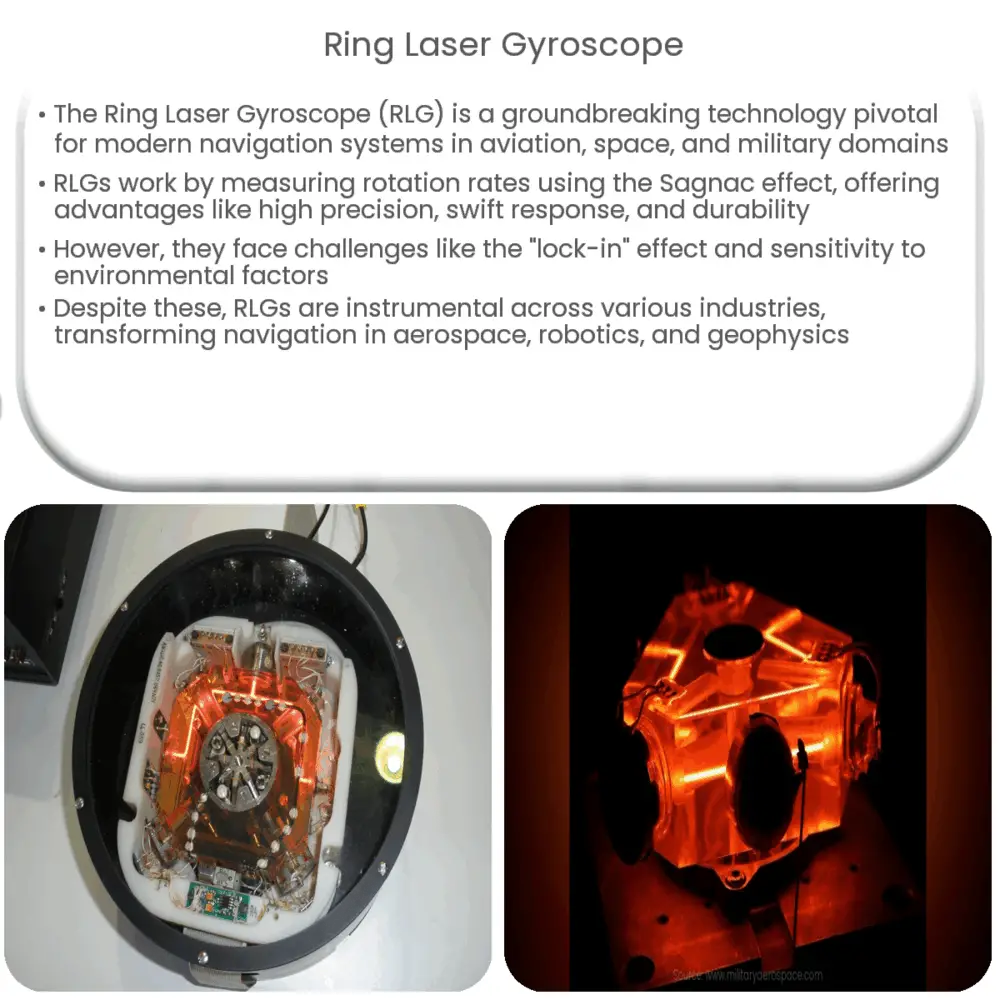Ring Laser Gyroscopes are optical devices that accurately measure rotation rates, widely used in navigation systems across aviation, space, and military applications.

Ring Laser Gyroscope: A Revolutionary Technology in Navigation
Introduction
The Ring Laser Gyroscope (RLG) is a cutting-edge technology that has significantly impacted navigation and guidance systems. As an essential component in modern Inertial Navigation Systems (INS), RLGs are widely used in various applications, such as aviation, space exploration, and military operations. This article will provide an in-depth understanding of the working principles, advantages, and challenges associated with RLGs.
Working Principle
Ring Laser Gyroscopes are optical devices that measure rotation rates by exploiting the Sagnac effect, a phenomenon discovered by French physicist Georges Sagnac in 1913. The RLG consists of a closed-loop optical path, typically in the form of a triangular or square ring, filled with a lasing medium. Two laser beams are generated and travel in opposite directions around the ring, creating an interference pattern when they meet again at the starting point.
When the gyroscope is stationary, the beams travel equal distances and the interference pattern remains constant. However, when the device is subjected to rotation, the beam traveling in the direction of the rotation covers a longer path, while the other beam travels a shorter distance. This path difference causes a shift in the interference pattern, known as the Sagnac effect. By measuring this shift, the rotation rate of the gyroscope can be accurately determined.
Advantages
Ring Laser Gyroscopes offer several advantages over their mechanical counterparts, such as the traditional spinning mass gyroscope. These benefits include:
- High precision: RLGs provide highly accurate measurements of rotation rates, which is crucial in navigation systems. The absence of moving parts eliminates friction and bearing-related errors, resulting in improved accuracy and long-term stability.
- Fast response time: Due to their optical nature, RLGs can respond to changes in rotation rate almost instantaneously, enabling precise measurements even at high rotation speeds.
- Reliability: With no mechanical components, RLGs are less susceptible to wear and tear, reducing the need for maintenance and increasing the overall system reliability.
- Compact size and lightweight: The compact design of RLGs allows for easy integration into various systems, making them suitable for applications with limited space and weight constraints, such as spacecraft and aircraft.
Challenges and Limitations
Despite their numerous advantages, Ring Laser Gyroscopes also face some challenges and limitations. These include:
- Lock-in effect: At very low rotation rates, the counter-propagating laser beams can become “locked” to each other, causing a reduction in sensitivity and potential measurement errors. This issue can be mitigated through dithering techniques, which involve applying small oscillations to the RLG to prevent the lock-in effect.
- Environmental factors: RLGs can be sensitive to temperature variations, mechanical stress, and vibrations, which may impact their performance. Advanced temperature control systems and vibration isolation techniques can help minimize these effects.
- Cost: The production of high-quality RLGs often requires specialized components and manufacturing techniques, resulting in higher costs compared to some other gyroscope technologies. However, ongoing research and development efforts are expected to lower costs over time.
Applications
Ring Laser Gyroscopes have found widespread use across various industries due to their high precision, reliability, and compact design. Some prominent applications include:
- Aviation: RLGs are commonly used in commercial and military aircraft for navigation, stabilization, and autopilot systems, ensuring safe and accurate flight operations.
- Space exploration: RLG-based Inertial Navigation Systems are employed in spacecraft and satellites for attitude control, orbit determination, and guidance during missions.
- Military: Modern military applications, such as guided missiles, unmanned aerial vehicles (UAVs), and ground vehicles, rely on RLGs for precise navigation and targeting.
- Robotics and automation: RLGs are utilized in various robotic systems, including autonomous vehicles and industrial robots, for accurate motion control and navigation.
- Geophysics and seismology: RLGs can be used to measure Earth’s rotation rate and detect seismic events, providing valuable data for scientific research and early warning systems.
Conclusion
The Ring Laser Gyroscope has revolutionized the field of navigation and guidance systems with its high precision, fast response time, and reliability. Although there are certain challenges and limitations, continuous advancements in technology are expected to further improve RLG performance and broaden their applicability. As industries continue to demand more accurate and reliable navigation solutions, the Ring Laser Gyroscope will undoubtedly play a significant role in shaping the future of various sectors, from aerospace to robotics and beyond.

